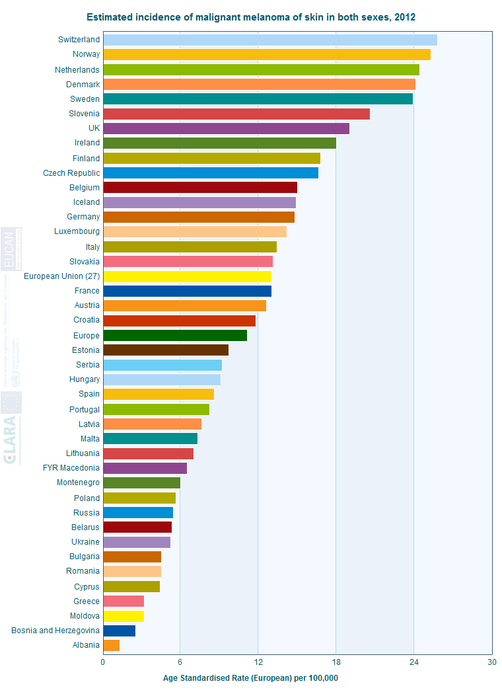
MPNEsupport Org 802492-1069, Sweden
Melanoma Patient Network Europe
Melanoma Molecular Map PROJECT
Great resource on Melanoma
Last update 19th December 2019 BR


More about Melanoma and Melanoma therapies
information on melanoma
The ASCO guide to Melanoma written for patients, also covers therapy options for advanced Melanoma but is somewhat indiscriminate to new and old therapies- Interleukin and chemo mentioned in same line with immune therapies e.g. Sections are regularly reviewed and approved by the Cancer.Net Editorial Board.
written for patients
by the american society of clinical oncology
Melanoma in short
- Cancer starting from pigment-producing cells, mostly but not only in the skin
- Survival very dependent on stage: Detected early, high chances of survival by surgery alone (95% cured). Detected late, fatal prognosis (average survival 6- 9 months without new medicines) (Gershenwald 2017)
- 144 000 new cases / year in Europe (Globocan 2018)
- 27 000 deaths / year in Europe (Globocan 2018)
- Traditional therapies alone (surgery, radiotherapy, chemotherapy) not effective once the disease has spread
- Novel break-through therapies have revolutionized treatment landscape, providing hope for long-term survival in advanced Melanoma for the first time ever.
- 10 new therapies plus combinations approved since 2011
- Patient highly dependent on innovative approaches to development of and access to new therapies
In Europa per year more than
100 000 new cases
22 ooo deathS
due to Melanoma
EUCAN 2012

(3) Forsea et al., 2012.Melanoma incidence and mortality in Europe: new estimates, persistent disparities. Br J Dermatol. 2012 Nov;167(5)
(4) Miller AJ, Mihm MC. Melanoma. N Engl J Med. 2006;355:51-65.
(5) National Comprehensive Cancer Network (2010), NCCN clinical practice guidelines in oncology(TM) - melanoma. V.2.2010.
(6) Globocan 2018
Melanoma is a cancer
that starts from the pigment-producing cells of the body, called melanocytes. Often, Melanoma starts on the skin with a mole but in rarer occasions, it can also start in the eye, on hand and feet, any inner surface of the body or in extremely rare instances, in any organ of the body like the heart or the meninges (soft wrappings for the brain and spinal chord). When Melanoma is discovered at a stage when it has spread, it can become impossible to identify the place where it has started.
Discovered early, Melanomas can be removed by surgery and patients have a very high chance of being cured. Once spread, it is sometimes called Malignant Melanoma (although Melanoma is always cancer, so it is always malignant). Without new medicines, patients will on average only survive 6-9 months after diagnosis, highlighting the importance of access to the new effective Melanoma treatments for our community.
the facts
- At a time, when most cancer incidences are falling, the incidence of Malignant Melanoma is increasing at a rate of 3- 7% in many European countries (1), compared to 2.6% in the US (2) and is expected to further rise (IARC projection).
- Incidence rates across Europe vary greatly, between 25.8 in Switzerland and 1.3 in Albania for 100 000 Europeans (EUCAN 2012). Please note that the validity of this data strongly relies on the existence of reliable cancer registries which cannot be assumed across Europe (3). The European average of 13/ 100 000 must therefore be considered as unnecessarily optimistic.
- Over the last 30 years only, the incidence of Malignant Melanoma hasrisen by 237% (2).
- Melanoma comprises only 4% of all skin cancers but is responsible for 80% of skin-cancer related deaths (4).
- Advanced melanoma is the fastest growing cancer in men and the second-fastest growing in women (5).
- Every year, more than 140 000 new cases of Melanoma are diagnosed in Europe (6) and more than 27 000 European citizen loose their lives to the disease (6).
Source
(1) Osterlind A. Epidemiology on malignant melanoma in Europe. Acta. Oncol. 1992;31(8):903-8.
(2) SEER, NCI


